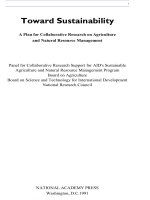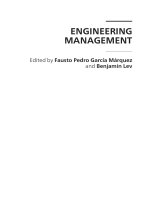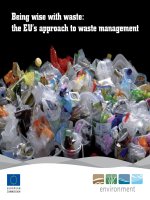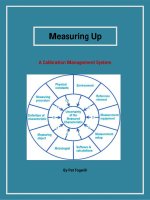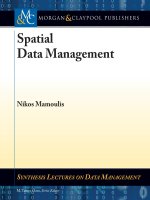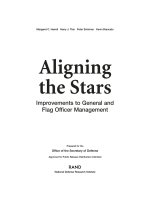MEASURING UP: Calibration Management potx
Bạn đang xem bản rút gọn của tài liệu. Xem và tải ngay bản đầy đủ của tài liệu tại đây (735.97 KB, 42 trang )
Measuring Up
A Calibration Management System
By Pat Fogwill
MEASURING UP
Calibration Management
Pat Fogwill (c)
Measuring Up – Pat Fogwill (c) 2011
ii
This edition published in Australia in November 2011 by
Metrology Solutions (Melbourne)
2/173 Albert Avenue, Boronia, Victoria, 3155. Australia.
(C) Patrick Fogwill
2011
All rights reserved. This publication may be transmitted in any form, by any means electronically or
mechanically, including photocopying, recorded or any information storage or retrieval system.
Distributed by:
Metrology Solutions (Melbourne)
For further information please contact:
Pat Fogwill, Metrology Solutions (Melbourne).
Measuring Up – Pat Fogwill (c) 2011
iii
DISCLAIMER OF LIABILTY.
MEASURING UP written from the experience of many years in the manufacturing and
service industries and has been published as an aid for those who wish to maintain or
develop a calibration management system.
The Author, the publisher, and the printers accept no liability for the results of actions and
decisions taken by anyone from reading this publication.
Measuring Up – Pat Fogwill (c) 2011
Page 1
Foreword:
Every day we make measurements, yet, do we consider the accuracy of that measurement?
If you are a provider of service or product then this publication will help you to take your quality
systems to levels that can save you time and money, improving your methodology and giving you a
clearer understanding on how to measure up.
In many cases measurements are made as a guide for approximating, therefore in this case the
measurement is loose or not accurate, but we still have an expectation of a limit as to the
uncertainty of that measurement. The degree of uncertainty is what we frequently determine (even
in our minds) as acceptable. The level of uncertainty or accuracy depends on the purpose for the
measurement. When manufacturing a product the quality depends upon its size or content, and any
error in measurement results in something of poor quality or totally useless.
The scope for making measurements is enormous, and most with wide-ranging consequence, such as
Occupational Health and Safety, Hygiene, Product Quality and Product Safety issues. My
background is engineering & engineering management in the industries of: Defence,
Telecommunications and Pharmaceutical, so I have seen, experienced and had to sort the most awful
“stuff-ups”.
This book outlines the methods for developing and maintaining your measurement systems, showing
how to determine and apply acceptable limits, ensuring that measurements are applied and used
with total confidence. The language used in this book does not mean that you have to be a scientist
or engineer to understand the methodology; it is a simple guide that takes you through the different
steps enabling you work and produce a quality service or quality product. Many of the steps you
may have completed to some degree even just in the mind, but the contents show you what is
required and the documenting of your procedures.
In the end you can have a measurement system that is structurally sound, that can be reviewed and
modified at any time, producing a calibration management system that ensures timely corrective
actions minimising errors and cost, and that will withstand audit. You will be able demonstrate by
documents and documented history that shows, “what you do is what you say you do”, and “what
you do meets the required standard”.
If your measurement is uncertain then so are your processes and products.
Measuring Up – Pat Fogwill (c) 2011
Page 2
Contents:
Foreword: 1
Calibration: 3
Traceability: 3
Setting the Limits: 5
As Found & As Left Limits: 5
Defining the limits for process measurement: 5
Defining the limits for the transfer measurement: 6
Defining the limits for the site standard measurement: 6
Calibration Factor: 7
Calibration Period: 8
Calibration Management Lifecycle: 9
Quality Document System: 9
User Requirement: 10
Design Qualification: 11
Operational Qualification: 13
Performance Qualification: 14
Installation qualification: 15
Calibration Documentation: 16
Calibration Master List: 17
Calibration Process Flow Diagram: 18
Equipment Labelling: 19
Calibration Reports: 20
Calibration Report – Support Documents: 22
Calibration Deviation Control: 24
Calibration Change Request: 25
Calibration Operation Procedure: 26
Calibration Training Documentation: 27
Company Quality Statement for Calibration: 28
Audit: 30
Audit Readiness: 30
Audit Checklist: 31
Audit Lifecycle: 32
Audit Notification: 32
Auditee Response: 32
Audit Process: 33
Audit Aftermath: 34
Audit Documents: 35
Audit Actionable Observation Report: 35
Audit Non-Compliance Report: 36
Audit Report Summary Sheet: 37
Summary 38
Measuring Up – Pat Fogwill (c) 2011
Page 3
Calibration:
Definition:
Determining the uncertainty of measurement.
To determine the difference between a measured value and the accepted true value.
The term is often used to describe the process of adjustment of measuring instruments to
align with a standard.
Traceability:
An essential function and should always be followed, if your measurement is not based upon the
accepted true value the results are bound to cause issues.
In many cases It is a requirement that measurements are traceable i.e.: Each measurement can be
traced through known standards up to an acceptable standard; such as “National”, “International” or
“Physical” Standards.
New technologies are enabling the metrology industry to declare standards based upon physical
standards, such as the number of atoms of carbon = 1kg. (This is not a figure I personally carry in my
head, nor would I want to, but you can see from such an example how the physical standards are
being defined).
For clarity of understanding and management there is a need to keep the number of traceable steps
to a minimum, below is a typical step by step traceable path you could adopt.
Process: - The limits applied for good quality of a product or service.
Process measurement: - Usually determined on or near the production line is the
most hard-worked equipment, subjected to and influenced
by the close proximity of interference (electrical, radio
frequency, thermal, humidity, mechanical vibration), and
should be installed and maintained in order to ensure the
limits of process are not exceeded. Traceability is taken from
the transfer measurement equipment.
Transfer measurement: - The equipment for calibrating the process measuring
equipment is used frequently and submitted to
environmental changes, and installed and maintained in
order to ensure the limits of the process measurement
equipment are not exceeded. Traceability is taken from the
site standard measurement equipment.
Site Standard measurement: - Master measuring instrument for your site, used for
calibrating your transfer measurement equipment, usually
located in an environmentally stable room, free from any
influencing properties, usually a Laboratory, and maintained
in order to ensure that the limits of the transfer standard
equipment are not exceeded. Traceability is taken from the
test house measurement equipment.
Measuring Up – Pat Fogwill (c) 2011
Page 4
Test House: - The equipment used for calibrating your equipment, usually
by a third party (preferably regulated by a testing authority) .
This equipment must be traceable and documented linked to
the acceptable standard.
Important: Each step from the “product” to the “Site Standard” is maintained by equipment with
lesser uncertainties than itself.
Measuring Up – Pat Fogwill (c) 2011
Page 5
Setting the Limits:
As Found & As Left Limits:
“As Found Limit” - Definition:
The maximum deviation level permitted between the measured value and the accepted true
value prior to any adjustment.
If this limit is exceeded the process / product quality may have been compromised for some
or all of the period since the last calibration.
“As Left Limit’ – Definition:
The maximum deviation level permitted between the measured value and the accepted true
value immediately following any adjustment.
This level also is the point at which you determine if adjustment is required; if the deviation
between the measured value and accepted true value is less than the “As Left Limit” then no
adjustment is required.
If this limit cannot be met immediately following adjustment then this indicates that the
equipment is not fit for purpose and should not be used and should be repaired or replaced.
Before setting the limits for accepted uncertainties, you must understand your requirements for the
product / process accepted quality limits:
Let’s say that the process is “to sterilize by steam, the containment for your product and that this is a
statutory requirement”, the sterilization temperatures must be 121.1 degrees Celsius with an
uncertainty of 1 degree Celsius.
Defining the limits for process measurement:
The process measuring equipment uncertainties for the value of 121.1 degrees Celsius must be less
than +/-1 degree.
The requirement is for the process measuring equipment to always be operational with uncertainties
equal or less than the “As Found Limit”.
The worst case difference between the measured value and the accepted true value is the
“As Found Limit”.
Service is only required when the “As Left Limit” is exceeded.
Calculating the ” As Found Limit” is determined as ½ of the process limit, then the “As Found Limit” is
+/- 0.5 degree Celsius (500mK).
Calculating the “As Left Limit” is determined as ½ of the “As Found Limit”, then the “As Left Limit” is
250mK.
Conclusion: The process measuring equipment will operate with the uncertainties up to 500mK and
will require service when the uncertainties exceed 250mK.
Measuring Up – Pat Fogwill (c) 2011
Page 6
Defining the limits for the transfer measurement:
The transfer measuring equipment uncertainties for the value of 121.1 degrees Celsius must be less
than 250mK.
The requirement is for the transfer measuring equipment to always be operational within or less
than the “As Found Limit” and the ”As Left Limit”.
The worst case difference between the measured value and the accepted true value is the
“As Found Limit”.
Service only required when the “As Left Limit” is exceeded.
Calculating the ”As Found Limit” is determined as ½ of process measurement limit, then the limit is
125mK.
Calculating the “As Left Limit” is determined as ½ of the “As Found Limit”, then the limit is 62mK.
Conclusion: The Transfer Standard measuring equipment will operate with the uncertainties up to
125mK and will require service when the uncertainties exceed 62mK.
Defining the limits for the site standard measurement:
The Site Standard measuring equipment uncertainties for the value of 121.1 degrees Celsius must be
less than 62mK.
The requirement is for the Site Standard measuring equipment to always be operational within or
less than the “As Found Limit” and the” As Left Limit”.
The worst case difference between the measured value and the accepted true value is the
“As Found Limit”.
Service / adjustment only required when the “As Left Limit” is exceeded.
Calculating the ”As Found Limit” is determined as ½ of transfer measurement equipment limit, then
the limit is 31mK.
Calculating the “As Left Limit” is determined as ½ of the “As Found Limit”, then the limit is 15mK.
Conclusion: The Site Standard measuring equipment will operate with the uncertainties up to 31mK
and will require service when the uncertainties exceed 15mK.
Measuring Up – Pat Fogwill (c) 2011
Page 7
Calibration Factor:
The examples given above use a factor of two between each step of the measurement maintenance
processes and is known as the “Calibration Factor”. A factor of 2, 4 or greater can be applied, the
greater the number the safer your system, but the greater the number the more difficult it becomes
to fit the required steps to the limits of the appropriate standards, i.e.:
Where AF=”As Found Limits” & AL=”As Left Limits”.
Using the previous example, we can easily calculate:
Using a Calibration Factor of 2
Process requirement: - 1000mK.
Process measurement: - AF = 500mK. AL=250mK.
Transfer measurement: - AF=125mK. AL=62mK.
Site Standard measurement: - AF=31mK. AL=15mK.
Test House requirement: - 7mK.
Using a Calibration Factor of 4
Process requirement: - 1000mK
Process measurement: - AF = 250mK. AL=60mK.
Transfer measurement: - AF=15mK. AL=4mK.
Site Standard measurement: - AF=1mK. AL=0.25mK.
Test House requirement: - 0.06mK.
Most test houses could not offer traceability with uncertainties this small, whereas 5mK is possible.
This example demonstrates that the calibration factor of 2 would work, where the factor of 4 would
not. The calculations using the factor of 3 would also demonstrate that this factor would not work.
It has been found by many years experience that the Calibration Factors of between 2 and 4 work
well and have produced world leading results.
Conclusion: Some critical processes may require some process control adjustment due to the derived
accepted uncertainties. The example shown is for the sterilisation by steam, using the control
parameters of 121.1 degree Celsius for 20 minutes. The actual temperature of the set point for the
process should now be set for 121.6 degree Celsius, allowing for the uncertainty of 500mK. For
greater certainty for the delivery of the sterilisation lethal dose, the time can be extended to 30
minutes. The process control parameters would now be 121.6 degree Celsius for 30 minutes.
Therefore the process parameters would now be 121.1 degree Celsius to 122.1 degree Celsius for 30
minutes.
Measuring Up – Pat Fogwill (c) 2011
Page 8
Calibration Period:
The calibration period is the period between each calibration. At each calibration the measuring
equipment is checked and the uncertainty of the measured value is compared with the accepted true
value to confirm that the equipment has been operating within the “As Found Limits”, and if required
the equipment adjusted / corrected to uncertainties less than the “As Left Limits”.
In adopting the correct calibration period it is expected that the measuring equipment uncertainties
lie within the determined limits, and the only time these limits are exceeded would be as a result of
equipment failure.
Depending upon the type of equipment being maintained and the working environment of the
equipment, the period can be set from days to weeks or even years. Experienced has demonstrated
that the best management period should not be set based upon calendar dates, as these are not
fixed periods, but by using the number of days or weeks or the multiples of weeks as: 1, 2, 4, 13, 26,
52 or multiples of 52 weeks, or periods in days set as 1, 2 or 3.
The management for setting the period should be flexible, that allows:
Extension of the period if the results of calibration indicate no adjustment required for up to
three calibration periods,
Reduction of the period if the calibration results indicated that limits have been exceeded
once.
It is obvious that prior knowledge is required in order to make decisions for setting calibration
periods. Here are three suggested methods:
1 Seek advice from the manufacturer or supplier.
2 Seek professional advice from instrument engineers, metrology consultants, or experienced
technicians.
3 Always plan and document test runs.
Whatever your decision, the period should always be tested, usually by being cautious and selecting
periods less than expectations, then modifying them based upon the results of calibration.
If the period selected is too long then product, process or occupational health and safety could be
compromised.
If the period is too short you are demonstrating that time and money is being lost due to
unnecessary maintenance and equipment over handling that can reduce the life expectancy of that
equipment.
If equipment demonstrates erratic behaviour between calibrations, the cause can be either; incorrect
selection of equipment, incorrect installation, incorrect maintenance procedures, system
inconsistencies or influence quantities from the equipment surrounding environment, i.e.;
Temperature fluctuation, humidity, pressure changes, radio, electrical or magnetic radiation or
electrostatic, just to mention a few. Whatever the cause, you will need to plan and make a thorough
investigation for several possible scenarios.
Measuring Up – Pat Fogwill (c) 2011
Page 9
Calibration Management Lifecycle:
Quality Document System:
The process of installing and maintaining any measurement system must be managed using a clear
step by step documented regime, which facilitates review in order for decision making, and
demonstration that all equipment selected can be maintained and is fit for purpose.
Planning: Prepare a written validation document:
Specifications: Specify what is required:
User Requirement.
Design Qualification.
Test Planning: Document how the equipment is to be tested:
Operational Qualification.
Performance Qualification.
Installation Qualification.
Testing: Perform tests and record results:
Installation Qualification.
Operational Qualification.
Performance Qualification.
Review: Review results for system performance:
User Requirement.
Design Qualification.
Installation Qualification.
Start here
Chec
k
Performance
Qualification
User
Requirement
check
Operational
Qualification
Design
Qualification
check
Installation
Qualification
System Build
The “V” Model.
The above documents are normally stored for easy access in a library, with files sorted by the
Location, Line, Machine, Equipment identity number. And remain active for the life of the
equipment, or as defined by regulatory bodies.
In the event of quality audits, reviews or product recall, investigations will require the information
contained in these files.
Measuring Up – Pat Fogwill (c) 2011
Page 10
User Requirement:
This document is generated to show and explain the basic requirements for the production of a
quality product/service:
The contents:
Product description / purpose. (What it is and what it does).
Regulatory controls.
Recipe / components of the product. (Details to include maximum and minimum limits
permitted).
Process steps and process descriptions. (How the product is made including the limits of
process or other influencing limits i.e.: Occupational health and safety, environment,
packaging, handling, and product life).
Expected production run sizes / batches / quantity, frequency and timelines for manufacture.
A table for each process stage showing :
o Process line title,
o Description of process,
o Measurement discipline,
o Engineering units used for each discipline,
o Range of measurements,
o Permitted tolerances.
o Special notes.
This document is to be:
Signed and dated by the User/Owner.
Reviewed, questioned and challenged by design group (User/Owner, Engineering, Quality
assurance). The User/ Owner to amend / update as required. Repeated review following
updates.
Engineering acceptance sign-off and dated as definitive and clear in content to be able to
establish the design phase.
Quality Assurance acceptance sign-off and dated as definitive and clear in content,
conforming to regulatory and quality standards, giving approval for establishment of the
design phase.
This document to be version controlled, capturing details and purpose for amendments and
updates.
Measuring Up – Pat Fogwill (c) 2011
Page 11
Design Qualification:
This document is a detailed plan generated from the user requirement showing and explaining how
the product is to be manufactured or service provided from the raw material to the final product,
including the machinery, locations, services, environment, and manpower in order for the
production of a quality product/service to be delivered within the expected timeline:
The contents:
Product/service description/purpose. (What it is and what it does).
Regulatory controls.
Recipe/components of the product/service. (Details to include maximum and minimum limits
permitted).
A breakdown detail of all the process steps, from the obtaining of raw material to the final
product, to include all of the process descriptions, equipment required, and manpower
required. (How the product/service is made, where it is to be stored, manufactured or
provided, including the limits of process or other influencing limits i.e.: Occupational health
and Safety, environment, packaging, handling, and product /service life).
Expected production run sizes / batches / quantity, frequency and timelines for manufacture
or provision.
Required environment (temperature, humidity, cleanliness, other; magnetic, electrostatic,
light, radiation protection etc.).
A table for each process showing :
o Process line title,
o Process line location,
o Description of process,
o Equipment description,
o Measurement discipline,
o Engineering units used for each discipline,
o Range of measurements,
o Permitted tolerances.
o Special notes. (Identifying any precautions taken from experience or advice given,
example: some chemicals demonstrate a tendency to be effected by electrostatic
charges causing “clumping” and errors of measurement due to magnetic influence. You
will need to define the methodology to minimise such effects).
Measuring Up – Pat Fogwill (c) 2011
Page 12
This document is to be:
Signed and dated by the responsible Engineer, and Engineering Management.
Reviewed, questioned and challenged by design group (User/Owner, Engineering, Quality
assurance). The responsible engineer to amend / update as required. Repeated review
following updates.
Engineering acceptance sign-off and dated as definitive and clear in content to be able to
establish the Installation phase.
User /Owner acceptance sign-off and dated as definitive and clear in content to be able to
establish the installation phase.
Quality Assurance acceptance sign-off and dated as definitive and clear in content,
conforming to regulatory and quality standards, giving approval for establishment of the
installation phase.
This document to be version controlled, capturing details and purpose for amendments and updates,
remaining a live document for the life of the equipment / process.
Measuring Up – Pat Fogwill (c) 2011
Page 13
Operational Qualification:
From the Design Qualification an itemised list of all required equipment is specified. This document is
later reviewed and updated following the development of the performance Qualification and again
following the Installation Qualification.
The purpose of this document is to identify the detailed operational requirements of each piece of
equipment and following the Installation Qualification how it is to be used, maintained and what
services are required for it to operate.
Initially the itemised list of equipment will identify maximum limits (operation frequency,
measurement limits, maintenance functions and limits) to be applied and the basis for those limits.
This document is to be:
Signed and dated by the responsible Engineer, and Engineering Management.
Reviewed, questioned and challenged by design group (User/Owner, Engineering, Quality
assurance). The responsible engineer to amend / update as required. Repeated review
following updates.
Engineering acceptance sign-off and dated as definitive and clear in content to be able to
establish the Installation phase.
User /Owner acceptance sign-off and dated as definitive and clear in content to be able to
establish the installation phase.
Quality Assurance acceptance sign-off and dated as definitive and clear in content,
conforming to regulatory and quality standards, giving approval for establishment of the
installation phase.
This document to be version controlled will be always a live document throughout the life of the
equipment, being updated and maintained based upon the history of operation.
Measuring Up – Pat Fogwill (c) 2011
Page 14
Performance Qualification:
Initially from the Operation Qualification this document itemises the actual limits expected to be
applied to each item of equipment. Then reviewed and updated to show that the actual
uncertainties and limits are within the defined limits as identified in operational qualification. The
review and update occur when testing during the equipment assessment and installation stage, and
then at regular periods through the equipment life. The data content of this document should reflect
the absolute capability of the equipment.
This document is to be:
Signed and dated by the responsible Engineer, and Engineering Management.
Reviewed, questioned and challenged by design group (User/Owner, Engineering, Quality
assurance). The responsible engineer to amend / update as required. Repeated review
following updates.
Engineering acceptance sign-off and dated as definitive and clear in content to be able to
establish the Installation phase.
User /Owner acceptance sign-off and dated as definitive and clear in content to be able to
establish the installation phase.
Quality Assurance acceptance sign-off and dated as definitive and clear in content,
conforming to regulatory and quality standards, giving approval for establishment of the
installation phase.
This document is version controlled and indicates that the equipment is fit for purpose for the stages
of selection, installation, operation and maintenance, therefore remains a live document for the life
of the equipment.
Measuring Up – Pat Fogwill (c) 2011
Page 15
Installation qualification:
From the initial Operational and Performance Qualification documents this document is developed
during the equipment selection stage, through to the final installed stage, and indicates the
equipment components (Title, Model, and Serial Numbers etc.), process stage, Manufacturer,
Supplier, Services details (Energy sources and distribution), applied limits, frequency and type of
maintenance and identification of Standard operation procedures to be used for operation and
maintenance.
This document is to be:
Signed and dated by the responsible Engineer, and Engineering Management.
Reviewed, questioned and challenged by design group (User/Owner, Engineering, Quality
assurance). The responsible engineer to amend / update as required. Repeated review
following updates.
Engineering acceptance sign-off and dated as definitive and clear in content to be able to
establish the ongoing operations.
User /Owner acceptance sign-off and dated as definitive and clear in content to be able to
establish the ongoing operations.
Maintenance Engineering acceptance sign-off and dated as definitive and clear in content to
be able to maintain the equipment.
This document is version controlled and amended and updated as required as a live document for
the life of the equipment.
Measuring Up – Pat Fogwill (c) 2011
Page 16
Calibration Documentation:
Calibration Master List:
Calibration Flow Diagram:
Equipment Labelling:
Calibration Reports:
Calibration Support Documents:
Calibration Deviation Reports:
Calibration Change Request:
Calibration Operation Procedures:
Calibration Training Documents:
Company Quality Statement for Calibration:
The above documents are normally stored for easy access in a library, with files sorted by the
machine/ equipment identity number. And remain active for the life of the equipment, or as defined
by regulation.
In the event of quality audits, reviews or product recall, investigations will require the information
contained in these files.
Measuring Up – Pat Fogwill (c) 2011
Page 17
Calibration Master List:
From the “Installation Qualification” the detail for the “Master Calibration List” is defined, and the
equipment details are:
Location: Building/Department/Line Number
Equipment Identity Number
Description of Equipment
The measurement discipline
The measurement engineering unit
The range of equipment
The resolution of equipment
The accuracy of the equipment
Make of equipment
Model of equipment
Serial Number of equipment
The criticality:
Product
Process
Safety
Other
The precision
Process minimum
Calibration Factor
As found Limit
As Left Limit
Operating procedure document number
Who Calibrates
Calibration period
This document should be dated with the approval signatories of the User/owner, Engineering
management and Quality Assurance management, and should be version controlled.
Measuring Up – Pat Fogwill (c) 2011
Page 18
Calibration Process Flow Diagram:
Start
Calibration
job obsolete
Work order issued
Calibration job
overdue
Enter “Job Obsolete”
on report
Follow procedures
Operation
Procedure.
Raise Deviation
report
Sign off report
As Found test
Fail
Label as Do Not Use
Raise Deviation
report
Enter AF results on
report
Enter AF results on
report
Raise Deviation
report
Label “Do Not Use”
As Left test
Fail
Adjust
Pass
As Left test
Fail
Adjust
Pass
As Left test
Fail
Adjust
Pass
As Left test
Fail
Enter AL results on
report
Enter AL results on
report
Raise Deviation
report
Sign off report
Sign off report
Label “Do Not Use”
Label “Calibrated”
Check equipment
report
Changes required
Raise Change
request
Frequency
Limits
Operation Procedure
Check & approve
File report
This document should be dated with the approval signatories of the User/owner, Engineering
management and Quality Assurance management, and should be version controlled.
Measuring Up – Pat Fogwill (c) 2011
Page 19
Equipment Labelling:
All equipment that is defined as critical must be identified using a label attached to the equipment.
The label to indicate:
Owner Company.
Location: Department/Line.
Equipment Identity Number.
Equipment Criticality.
Equipment Description.
All critical measuring equipment must have a calibration status label attached indicating:
Equipment Identity Number.
When Calibrated.
Calibration next due.
Who calibrates. (Name of responsible person or contracting organisation).
The above criteria are best contained in a single clear label holder, below shows a template for the
labels, where the calibrated label is positioned at the bottom of the equipment identity label within
the holder.
Label 1/2
Equipment Owner
Location: Dept / Line
Equipment Identity Number
Criticality
Description
DO NOT USE
Label 2/2
Equipment Identity Number
When Calibrated
Calibration Next Due
Who Calibrates
CALIBRATED
The completed calibrated label is positioned at the bottom of the equipment identity label within the
holder, covering the “DO NOT USE” section.
Equipment Owner
Location: Dept / Line
Equipment Identity Number
Criticalit
y
Description
DO
Equipment Identity Number
When Calibrated
Calibration Next Due
Who Calibrates
CALIBRATED
Measuring Up – Pat Fogwill (c) 2011
Page 20
Calibration Reports:
Calibration Report
Page
<#>
/
<#>
Equipment I.D. #
Work Order #
Date
SOP
Description
Depar
tment
Location
Equipment used:
Equipment I.D.#
Description
As Found Results:
Warm up time
Confirmed
Reference Value
DUT value
Error
Limit
Pass/Fail
Measuring Up – Pat Fogwill (c) 2011
Page 21
Calibration Report
Equipment I.D
Work Order #
Date
Page
<#>/<#>
As Left Results
Warm up time
confirmed
Reference Value
DUT value
Error
Limit
Pass/Fail
Comments:
C
alibrated By:
Date:
Checked By:
Date:
This document should be version controlled, ideally as a part of an Operation Procedure.
